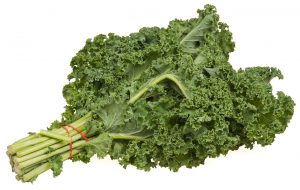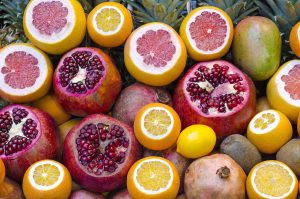What’s that in your smoothie? Kale, avocado, blueberries? Sounds like a who’s who of superfoods! But let’s take a minute and think about that word: “superfood.” Seems like it’s been thrown around so much for so long now that maybe we don’t really know what it means anymore – if it ever meant anything in the first place. Sure, we can fill our plates with pricey, hyped-up foods like quinoa or acai, or make one type of leafy green, fish, and fruit the focus of our diet, but is that really going to give our health the supercharged boost that we hope it will?
Before you clear out your cupboards and fridge of anything that hasn’t been dubbed a superfood, take a look at what that word actually means, which foods are worth the hype (and which aren’t), and how you should really be planning your plate.
The Origins of the Superfood Fad
You might think that the idea of the superfood was invented when we all somehow “discovered” kale not so long ago – do you remember when Bon Appetit dubbed 2012 the “year of kale?” Ok, we don’t really either, but still, the point is it’s been popular for a while now, but that’s not where the term superfood comes from: it actually dates all the way back to the early 20th century! And guess what? It was part of a marketing strategy.

The United Fruit Company had started majorly importing bananas into the U.S. and decided to market their haul by dubbing the fruit a “superfood” that was cheap, easily digestible, delicious raw or cooked, very nutritious, and portable. The term caught on after being endorsed in medical journals (who agreed that bananas were banana-rific, and could even cure celiac disease); the fruit company used the endorsements in their advertising, and the cycle of creating a craze around a so-called superfood was born.
This craze-creating cycle has continued into the 21st century, with scientific research on a particular food creating buzzy headlines that can then be used in marketing campaigns from food industries. Marketing of these foods has been steadily increasing: according to Mintel research, in 2015 there was a 36% increase globally in the number of foods and beverages launched that were labeled as a “superfood,” “superfruit,” or “supergrain,” with the U.S. being the main target market. And the marketing seems to be working: the global superfoods market size was estimated at $137 billion in 2018, and according to a Nielson survey of 30,000 global shoppers, consumers are willing to pay more for foods perceived as healthy.
As researchers wrote in Nutrition and Cancer, “Stories of ‘miracle foods’ sell magazines and advertising space; food industries often sponsor research to show that their foods or products are superior, and supplement industries look to boost sales.” So what are these supposed “miracle foods,” and is there any truth behind the hype?
What Are Superfoods?
While the term superfood doesn’t have a scientific definition, it’s become so popular that it does have an entry in Webster’s Dictionary. According to them, it’s “a food (such as salmon, broccoli, or blueberries) that is rich in compounds (such as antioxidants, fiber, or fatty acids) considered beneficial to a person’s health.” As for what’s on the list of superfoods, it’s constantly growing, but includes the following, among others:

- blueberries
- kale
- goji berries
- chia seeds
- maca
- spirulina
- citrus fruits
- acai berries
- cocoa
- ginger
- garlic
- flaxseeds
- chia seeds
- chili peppers
- pomegranate
- wheatgrass
- turmeric
- green tea
- salmon
- avocado
- cruciferous vegetables
- beets
Are They Real?
When thinking about these foods, it’s worth remembering our point above that elevating them to the level of superfood is more about marketing than about science: they might have a unique and mystical backstory about how they’re found in the depths of the Amazonian rainforest or that they were a food of the Ancients, or they might be highlighted for their antioxidant properties, or supposedly unique nutrients.
But that doesn’t mean that they’re not great for you, and shouldn’t be a part of your diet, because they are typically a concentrated source of vitamins, minerals, and beneficial plant compounds, such as polyphenols and carotenoid, known to positively impact health in a number of ways, including reducing inflammation and protecting against cellular damage.
That being said, dubbing foods “superfoods” can be problematic, and misleading: many scientific studies done on these types of foods are inconclusive, incomplete, or just, well, a bit overhyped. “If you look at the actual studies that have been done on ‘superfoods,’ sometimes [the conclusions drawn from them are] excessive to the point that [they’re] not realistic,” says Colorado-based registered dietitian Jessica Crandall Snyder.
On the other hand, though, the proof behind the super-ness of some foods is more conclusive than for others:
- Berries – Some studies show that berry consumption might have links with improved vascular function and reduced heart disease risk factors, but further research is still needed.

- Cruciferous veggies – Diets high in cruciferous vegetables, such as kale, broccoli, and cauliflower, also have links to a lower risk of heart disease and certain cancers.
- Leafy greens – Greens like watercress, purslane, collard greens, and Swiss chard have an abundance of antioxidant and anti-inflammatory compounds such as polyphenols and carotenoids that may help protect against cellular damage, and offer protective effects against health conditions, including cardiovascular disease and type 2 diabetes. They are also high in many vitamins and minerals.
- Omega-3 rich fish – Salmon, mackerel, herring, and sardines all have this important fatty acid and other important nutrients.
- Garlic – It might have a reputation as a date night ruiner, but garlic has been shown to provide anti-cancer, anti-diabetic, and anti-hypertensive effects.

- Citrus fruits – These refreshing favorites are filled with anti-inflammatory and antioxidant metabolites, including flavonoids, alkaloids, carotenoids, coumarins, phenolic acids, and essential oils.
It Doesn’t Have to Be Superfood or Bust
While there’s no doubt that the foods above are super healthy and should be included in a balanced diet, there is doubt over using the term “superfood,” with health experts these days skeptical – to say the least – about using the term. Some argue that it encourages people to eat their leafy greens, but others argue that it can actually cause more harm than good.
Notice, for example, that bananas, the OG of superfoods, don’t make the cut these days, and because they aren’t hailed as “super,” many people dismiss good-for-you fruits like bananas just because they don’t have as many antioxidants; meanwhile, bananas are a good source of potassium and the average American only gets about half of their recommended potassium.
We shouldn’t be excluding other foods that aren’t so “super,” any more than we should think that eating a few superfoods will cancel out other, not-so-super lifestyle choices. What’s more important than focusing on adding superfoods to your diet is that you eat a wide variety of nutritious foods (as well as get regular physical activity and avoid a sedentary lifestyle). According to Kim Robien, director of the Public Health Nutrition program at George Washington University’s Milken Institute School of Public Health, “We know that long-term dietary patterns, rather than any single food choice or eating occasion, is what matters for overall health.”
What’s more, it’s not a good idea to limit what you eat: “Foods are complex mixtures of thousands of chemical compounds, most of which we still have yet to identify,” she says. “It is likely that these compounds play important roles in our overall health, and probably work together to achieve those health outcomes. Thus, it’s always better to eat a wide variety of different fruits and vegetables. Diets that focus too heavily on any one food item are more likely to be deficient in key nutrients.”
And you don’t have to spend a lot on overpriced, hyped-up foods, or force yourself to eat anything that’s not your cup of (matcha) tea. There are many so-called superfoods that have just as healthy, if not healthier, alternatives. For example (and this is by no means an exhaustive list):
- Quinoa – This ancient grain (or more accurately, seed) does contain more iron and protein than many other grains, and it is considered a complete protein, but don’t forget your oats – they actually have a similar amount of protein and more fiber than quinoa!
- Chia seeds – These tiny black seeds are great for making thick healthy puddings, but if they’re not your thing, you can rest assured that, while chia seeds are great for Alpha-lipoic acid (ALA), oily fish are better for Docosahexaenoic acid (DHA), which is more important. Or, if you want to swap them out for a different seed, flaxseeds and kiwi seeds are great for you.
- Acai and goji berries – These berries seem super healthy – and they have a super price tag to match – but studies on them are inconclusive, and other, more readily available berries, have more solid science behind them.
- Kale – It’s tough for us to say anything against kale (and you know what, there really isn’t anything to say against it!) but, for all the hype surrounding this green, it doesn’t actually top the list of the healthiest greens. Shocking, we know! That honor actually goes to watercress, with Chinese cabbage, Romaine and leaf lettuce, and spinach all taking out higher rankings than kale.
Bottom line: no one food (or even handful of foods) is going to be a cure-all. There aren’t magical foods (unfortunately) that will make you shed extra pounds, ward off all cancers, or keep you fighting fit until you’re old as the hills. But, with that being said, eating a variety of nutrient-dense foods (that you enjoy, and that won’t put an unnecessary burden on your budget), is a big part of maintaining a healthy lifestyle and preventing disease, so you can get the most out of life. Now go and enjoy that smoothie!
